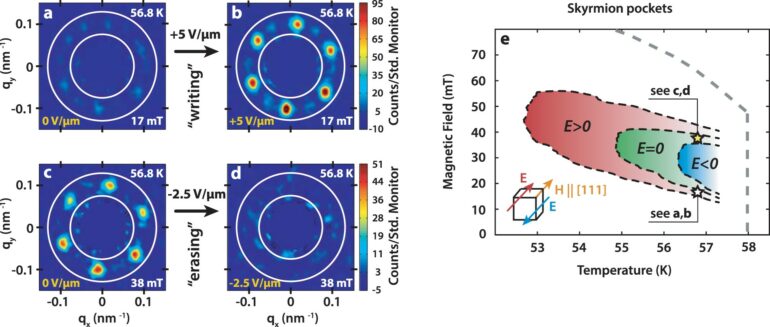In a discovery that could have important implications for low-power computer memory, RIKEN researchers have shown that an entire sample can be switched between different magnetic states, or phases, simply by applying an electrical current.
The atoms or molecules in a material can interact with one another in many ways and to different degrees. In gases, for example, atomic or molecular interactions are very weak, whereas in solids they are much stronger. And solids can have many more of these so-called phases of matter.
A specific phase might be defined by the relative physical arrangement of the atoms or molecules or by the alignment of their magnetic properties. And each type of ordering gives the material a different set of properties.
Changes between these phases are potentially a useful way to store data. For example, creating tiny magnetic swirls known as skyrmions has been proposed as an energy-efficient way of creating high-density computer memory. While each skyrmion is very small, the ability to change the phase across an entire sample opens exotic routes for controlling the properties of microscale materials.
“It’s well known that such global phase transitions can be induced by changing environmental parameters, such as the temperature, magnetic field or pressure,” explains Fumitaka Kagawa from the RIKEN Center for Emergent Matter Science. “But it wasn’t certain whether an electric current could induce global phase changes.”
Now, Kagawa and his colleagues have used an electrical current to induce a global phase change in an alloy made of manganese and silicon.
The team created an 18-micrometer-long bar of manganese–silicon alloy and connected electrical contacts to it. Electrical measurements confirmed the emergence of a skyrmion phase at a temperature of around −250°C.
When the team passed a current through the bar, they observed a change in the material’s properties that was indicative of a switch between a skyrmion and a non-skyrmion state. Their results were supported by numerical calculations.
Importantly, the team ruled out the possibility that this change occurred due to the current heating the material, so it was not a thermodynamic phase transition. Also, the same results were not seen in much larger samples, indicating that the confined geometry plays an important role in the non-thermodynamic phase change.
“A sample under a strong current is generally in what is called a non-equilibrium steady state, which is not well understood by today’s well-established theories of thermodynamics and statistical mechanics,” says Kagawa. “So our results make clear that dramatic phenomena such as phase changes can occur even in these poorly understood regimes.”
The study is published in the journal Physical Review B.
More information:
Takuro Sato et al, Nonthermal current-induced transition from skyrmion lattice to nontopological magnetic phase in spatially confined MnSi, Physical Review B (2022). DOI: 10.1103/PhysRevB.106.144425
Citation:
An electrical change of phase using skyrmions (2023, February 27)
